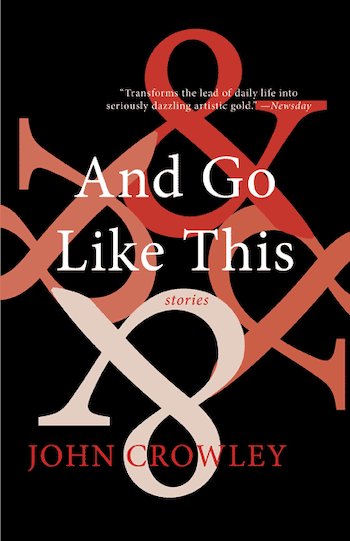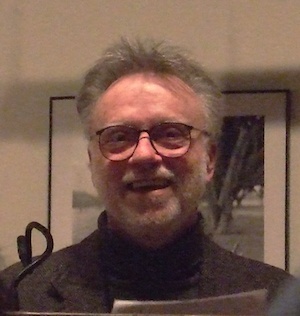Book Review: “And Go Like This” — Short Stories of Distinction
By Vincent Czyz
The stories in And Go Like This are wise, compassionate, and deftly crafted.
And Go Like This by John Crowley. Small Beer Press, 336 pages, $25.
Click here to buy.
 No less a critic than Harold Bloom called John Crowley‘s Little, Big (1981) “an imaginative masterpiece in which the sense of wonder never subsides.” Comparing it to Lewis Carroll’s Alice in Wonderland, he told an interviewer that he’d “read and reread the novel at least a dozen times,” always coming away “startled and refreshed.” Pulitzer Prize–winning book reviewer Michael Dirda claimed the Aegypt tetralogy, perhaps Crowley’s crowning achievement, “confirms that he is one of our finest living writers, period.”
No less a critic than Harold Bloom called John Crowley‘s Little, Big (1981) “an imaginative masterpiece in which the sense of wonder never subsides.” Comparing it to Lewis Carroll’s Alice in Wonderland, he told an interviewer that he’d “read and reread the novel at least a dozen times,” always coming away “startled and refreshed.” Pulitzer Prize–winning book reviewer Michael Dirda claimed the Aegypt tetralogy, perhaps Crowley’s crowning achievement, “confirms that he is one of our finest living writers, period.”
With this sort of praise for Crowley, I’m reluctant to admit that And Go Like This, published late last year, is my introduction to his work. The collection consists of 13 stories, one of which is a flash fiction, two of which qualify as novellas. While Crowley made his bones in speculative fiction and fantasy (faery folk are the “little” in Little, Big), most of the stories rely on realism or something so close to it you may not realize you’re seeing a mirror image of the real.
All but the two shortest stories circle, hawk-like, over a book, books in general, and/or a writer. The opening tale, for example, “The Girlhood of Shakespeare’s Heroines,” expends quite a few pages debating the true identity of the Bard, peering into critical volumes, and acquainting the reader with the author of one such volume. “Spring Break” takes place on the campus of a futuristic Yale, where the university library’s hoarded books — rather than their online counterparts — lie all but discarded. The setting of “This Is Our Town” resembles a rural enclave in Norman Rockwell’s America, but it’s more like a chapter added to an actual book (of the same name) penned for Catholic children circa 1953. The narrator of “The Million Monkeys of M. Borel” is a Jorge Luis Borges lookalike who speculates on chance and its relation to the written text. “Flint and Mirror” is a metatext revolving around a fragment of writing “recently discovered among uncatalogued papers of the novelist Fellowes Kraft” (who appears in the Aegypt novels). The final story is about a novelist who reimagines — perhaps relives — his life as a screenwriter. And so on.
The collection leads off with “Shakespeare’s Heroines,” which begins as a coming-of-age story but extends into maturity: a summer romance between college students is interrupted by polio and picks up again more than two decades later. The story opens in the late ’50s at an unlikely Shakespeare festival in Indiana, where a circular barn abandoned by a failed utopian community is converted into a theater and manned by interns, actors, and a director.
If the narrator has a name I’ve forgotten it, mainly because the real protagonist is Harriet, the young woman he falls for. With a subtle touch — a refreshing break from the chest-thumping identity politics on display in too many contemporary fictions — Crowley portrays her as stubbornly but quietly self-reliant, and, even though polio damages her more severely than it does him, she’s the more able of the two when the story picks up again in 1980.
Harriet’s mother, we are told, is a “Free Spirit,” a much-discussed entity in the novella: “somebody who does what they want. Like a Victorian lady who asks a man to marry her. Or just be lovers.” Or sleeps “around wherever,” with whomever. This description does indeed fit Harriet, who makes no apologies for doing as she pleases, particularly when it comes to her sexuality. Conceptually, Free Spirits feed into the larger theme that “nothing needs to be the way you’ve always thought it has to be” — whatever the powers that be say to the contrary.
Much of Crowley’s technique is allusive: the utopian community failed, so will the Shakespeare festival (as an annual affair). The barn-cum-theater is round; so was the Globe Theatre (where the Bard’s plays were first performed). More conspicuously, Harriet in some ways is another incarnation of Delia Bacon, both a Free Spirit and an actual 19th-century Shakespeare scholar whose book lends its title to the story. Moreover, Harriet insists that Delia was “killed by Shakespeare,” while she and the narrator “got sick from Shakespeare.” Its characters well developed, its descriptions (especially of landscapes) often lyrical, its emotional freight balanced against intellectual heft, this might be the strongest piece in the collection.
At 86 pages “Mount Auburn Street,” a triptych of three tales, is the longest. Harry, now 60 and an author (no surprise there), is homeless after his house burns down thanks to a collection of paint cans he kept forgetting to dispose of. Living with his daughter, he’s disturbed by the fact that he can’t remember his dreams. This prompts him to participate in a cognitive rehabilitation program, where he undergoes a battery of tests and meets regularly with a neurologist. It’s a story of aging and memory, sometimes in the Proustian sense of passed time mnemonically resurrected (color rather than smell is the trigger for Harry), sometimes in the practical sense (those paint cans), sometimes in the sense of loss (his dreams). While there’s generally something conceptual Crowley is trying to work out in his fictions, such as the nature of memory, the fictions are generally enriched rather than impoverished by his intellectual curiosity.
The middle tale in “Mount Auburn” revolves around Harry’s friend Stan, a real estate agent who decides to take Viagra to keep up with his wife after hormone treatment jump-starts her sex drive, but aging bodies able to perform like youthful ones are only half the equation, and Stan has to face the disturbing reality that his marriage may need more than an enduring love to survive.
In terms of pacing, character portrayal, low-key plot, and even the setting, “Mount Auburn” reminded me of some of John Updike’s short fictions, especially “A Sandstone Farmhouse.” Like “Farmhouse,” “Mount Auburn” feels more like we’re passing over a life in a glass-bottom boat than reading a story. A lot of it has to do with the writing, although where Crowley is quietly convincing, Updike is insistent. Whereas Updike impastos pages in lyrical detail, Crowley chooses one or two that imply the rest. Here, for example, he evokes the stillness after a sexual encounter: “Outside the bugs and beasts seemed to have fallen silent, shocked, but Stan could hear—returning him to the world—the far-off rattle and wail, far down in the valley, of the only night train.”
The two best stories, though they excel in different ways, are the aforementioned first and “Anosognosia,” the last. Together, they bookend the collection, while “Mount Auburn” anchors the middle. “Anosognosia” is markedly different from the other fictions, which tend to proceed at a leisurely pace — walks in a forest whose foliage induces dallying — but this one moves at a quick clip and is at times suspenseful.

John Crowley reading at NYC’s South Street Seaport in 2007. Photo: Wiki Commons.
In May 1959 John C., a high school junior in Indiana, trips down the stairs and lies comatose for a few days. When he awakes, he’s clearly altered. No longer “dreamy,” “intensely inward,” “bookish,” he’s now more worldly, assertive, and self-assured, with a clear plan for his future. The first step includes writing “The Bureau of Second Chances,” a story intended as a Twilight Zone episode, in which a man finds a way to go back to a specific moment in his life and make a different choice. The story is sold, produced for television, and by middle age John C. is a successful, unmarried screenwriter living in Los Angeles. But the proverbial plot thickens. While in therapy with Carla Young (phonetically kin to Freud’s most famous disciple), John C. insists that he had another life in which he was a moderately successful novelist living in New England with his wife and two daughters, that he—like the character in his short story—was given the chance to go back and make a different set of choices. But there’s a twist: on his 50th birthday he has to decide whether he wants to keep the life he has or return to the one he abandoned. The therapist thinks he’s suffering from a psychological disorder call anosognosia, in which the afflicted person is “incapable of recognizing an illness,” even one such as paralysis, “which seems impossible to deny.” To complicate the story further, not only is John C. aware of the condition, he made a film titled “Anosognosia.”
So we have mirrors reflected in mirrors. John C. could be Crowley himself, who grew up in Indiana, was in high school in 1959, relocated to New York City after college to become a filmmaker but became a novelist instead, moved to New England, married, and has two daughters. Clearly the story has a biographical dimension. And then there is Crowley’s fondness for Borges, which I’m inferring from the sixth story; I wouldn’t say “Anosognosia” is based on Borges’s seminal “Garden of Forking Paths,” but take an X-ray of Crowley’s tale and you might see the ghostly outlines of Borges’s, which posits not “a uniform, absolute time” but “an infinite series of times, in a … dizzying net of divergent, convergent, and parallel times.” Thus there are endless alternative histories — only John C. managed to transfer, as though on a subway line. On another level “Anosognosia” is an exploration of the choices we make, which, along with the consequences of those choices, add up to our lives. Still another layer down is Aristotle’s Poetics, in which those choices and their ramifications comprise a plot.
So, has John C. really found a way to return to 1959 and reinvent his life? Is he delusional? Or is he a character concocted by the novelist John C. in the story, who himself is the brainchild of John Crowley? The — dare I say it? — choice is yours. And if you choose the latter, isn’t it fun that the fictional John C., the screenwriter, used his own life as a model for his first story, “The Bureau of Second Chances” (just as Crowley used some of his biography to create John C.)? Whichever answer is “correct,” if there is a correct answer, this is an entertaining story with the regressing labyrinthine depths that mesmerized Borges and his readers.
The stories in And Go Like This are wise, compassionate, and deftly crafted. Rather than straining to hold an operatic note, they tend to hum. Don’t be surprised if you find yourself humming along.
Vince Czyz is the author of The Christos Mosaic, a novel, and Adrift in a Vanishing City, a collection of short fiction. He is the recipient of the Faulkner Prize for Short Fiction and two NJ Arts Council fellowships. The 2011 Capote Fellow, his work has appeared in many publications, including New England Review, Shenandoah, AGNI, The Massachusetts Review, Georgetown Review, Quiddity, Tampa Review, Boston Review, and Louisiana Literature.

It can be imagined how gratifying Vincent’s fine — generous and also perspicuous — review of a collective of mostly unmatching tales. The neatest sentence [to me, for obvious reasons] was this one: “Thus there are endless alternative histories — only John C. managed to transfer, as though on a subway line.” Wish I’d thought of that.